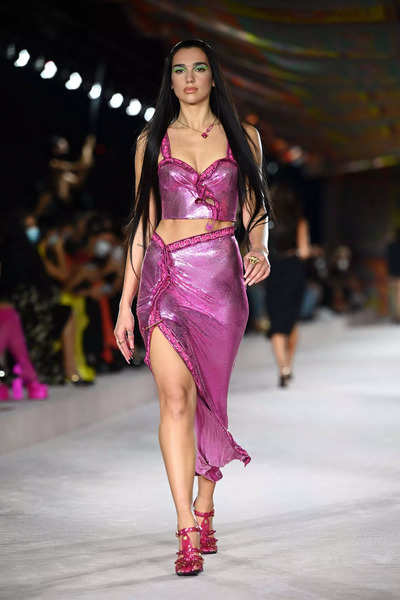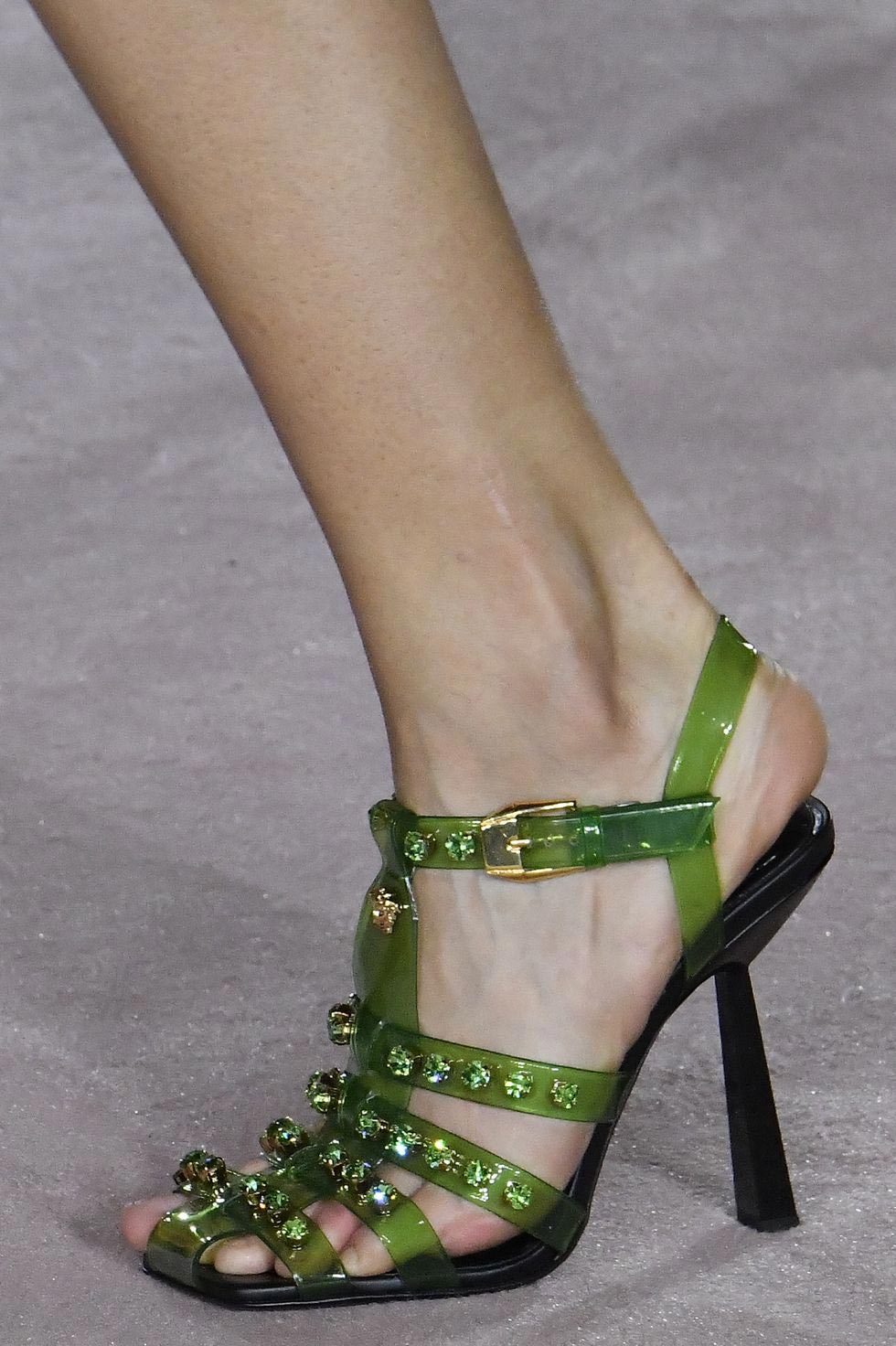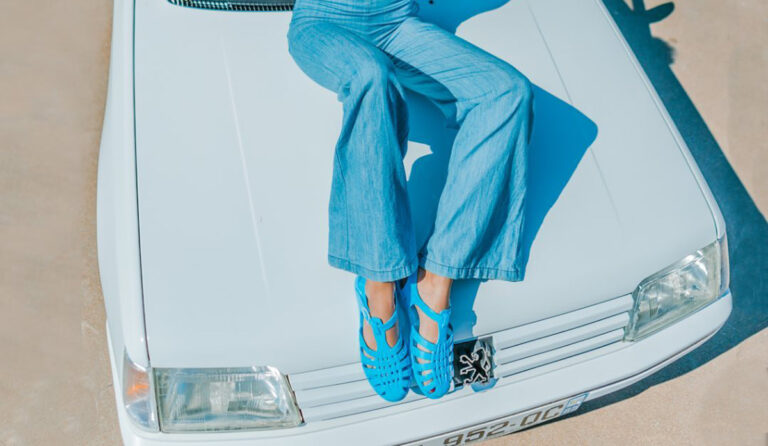Jelly shoes are having a Y2K moment at the cost of our environment, again
The year is 1995 and you’ve just landed a movie date with your bestie. Donning a plaid skort, you match the rubber bands on your braces to the butterfly clips in your hair before digging through your wardrobe to find your favourite pair of shoes. Wiggling the squishy backstrap between your fingers, they land with a ‘splat’ on the ground, which doesn’t scare you from slipping them on. Lo and behold the iconic jelly shoes, my blistered friends. Irrespective of whether you loved or loathed them, the jelly creations are back—currently making rounds as the official footwear choice of the monsoon.
What are jelly shoes?
Injection-molded soft plastic footwear—commonly known as jelly shoes or jellies since the former is a mouthful—are a type of shoe first introduced back in the 80s. Made from Poly Vinyl Chloride (PVC), they typically cover your toes and branch into strips with a single piece running all the way up to the fastening in the front. Given their base material, jelly shoes are mostly transparent and available in every colour imaginable. They can additionally feature non-transferrable glitter and My Little Pony stickers—with the design of the shoe being woven or solid. What’s more? They only cost $1 back in simpler times!
Introduced by Grendene, a Brazil-based company, jelly shoes were marketed and distributed in the US after their initial debut at the 1982 Knoxville World Fair. In fact, the company took jellies so seriously that it used to restyle the product every six months or so to stay ahead of competing companies. Fast fashion, who? Back when they were introduced, jelly fans raved about the shoes until they were labelled as a must-have. I mean they were cheap, came in the wildest colours possible and were practically indestructible. You could literally buy a pair to match every single item in your wardrobe.
Coveted for these two factors, jelly shoes have witnessed frequent revivals since their appearance, peaking in the late 90s. In 2006, Grendene had manufactured close to 131 million pairs of the jelly creations. Fifteen years later, the shoes have, once again, withstood the test of time—promising not only a dip into nostalgia with all things Y2K, but also vowing to keep your toes dry during the monsoons.
Triggered back into action by trailblazer Blake Lively in June 2021, it was only a matter of time before everyone from Alexa Chung and Simone Rocha to Gucci and Giorgio Armani paraded them down the runway, some encrusted with jewels while others decked out in feathers. Dua Lipa also nailed an updated version of the 90s favourite at Versace’s Spring/Summer 2022 collection during Milan Fashion Week. According to the global fashion search platform Lyst, online searches for ‘jelly sandals’ have boomed since April 2021—with an 82 per cent month-on-month increase post their catwalk domination. To sum up, the ‘blast from the past’ creations are here to stay for now as gen Z’s obsession with recreating a time they missed out on while still in diapers carries on.


A double-edged plastic sword
Whether or not you choose to break your feet into a pair of jelly shoes this rainy season, it’s time to address some burning questions that tag along with the trend’s comeback in 2021—a rather climate-anxious year if you ask me. How eco-friendly are jelly shoes? Do the ones marketed as ‘100 per cent recyclable’ hold true to their claims or are fashion giants trying to greenwash their way out of the questionable material? In order to break this down, let’s look back at the ‘cheap’ production process backing the footwear.
Making jelly shoes is a pretty straightforward process. How Stuff Works noted how Grendene uses Computer Numerical Control (CNC) machines to shape different moulds. The jellies are then formed by injecting resin—along with other additives required to adjust the shoes’ rigidity, texture and colour—into them. The majority of jelly shoes, however, are made from PVC, which Greenpeace claims to be “one of the most toxic substances saturating our planet and its inhabitants.” According to the group, toxic chlorine-based chemicals are released at every stage of PVC’s production, use and disposal, resulting in health problems like cancer, immune system damage and hormone disruption.
A report from the Global Development and Environment Institute at Tufts University expands on these claims by stating how the PVC production process exposes workers and communities to vinyl chloride and other toxic substances. “PVC products such as medical equipment and children’s toys can leach toxic additives during their useful life,” the report reads. “Vinyl building materials release hydrochloric acid fumes if they catch fire while burning PVC creates byproducts including dioxin, a potent carcinogen.” So why is the toxic material used to make jelly shoes in the first place? Cue cheap production costs coupled with long lasting and low maintenance properties.
In an interview with The Guardian, Natalie Fee, the founder of City to Sea—an environmental organisation campaigning to stop plastic pollution—explained how jelly sandals epitomise the folly of fashionistas. “Why would you want to be seen in something made purely of fossil fuels, most likely from fracked gas, in the middle of a climate emergency?” she said. According to Julian Kirby, a campaigner at Friends of the Earth, the key concept backing such products from an environmental point of view is that it’s built to last. “This is especially important with shoes, as poorly made ones barely last one holiday,” he added. In short, jelly shoes are indeed built to last, which is sustainable because it prevents the need for additional shoe purchases. But what about the eco-friendliness of the product’s lifecycle?
Considering consumers’ foray into sustainable brands, Brazil-based Melissa footwear and UK-based Juju, which supplies the likes of ASOS and Urban Outfitters, are promising recyclable jellies. According to enthusiasts, the former sells non-toxic, hypo-allergenic, cruelty-free and vegan jelly shoes while the latter sources its materials from England and grounds old shoes up to make new ones. However, little information exists to back up these environmental claims. Lynn Wilson, a consultant and consumer researcher noted how this is the key problem for consumers when it comes to such sustainable statements. What does ‘recyclable’ even mean from a corporate point of view? Is ‘eco-friendly’ PVC actually a sustainable material?
An investigation by EcoSalon revealed how Melissa shoes are made from Melflex, a type of PVC which was developed and patented by its parent company Grendene—which states that the technology it employs for development is “the most sustainable and ecologically correct in the world market.” Melissa’s official website also claims PVC to be “one of the most sustainable thermoplastics available” while Melflex is “versatile, durable, totally reusable and extremely environmentally friendly.”
Heck, Grendene’s annual report—as noted by EcoSalon—goes as far as stating that “when disposed of, PVC shoes can be entirely recycled, burned for recovery of energy, or even sent to landfills since they do not contaminate the soils or water tables.” According to both The Guardian and the BBC, however, PVC is almost never recyclable through local councils and can contaminate other plastic recycling—contrary to what the corporation claims.
These brands do offer solutions, on the other hand. For starters, Melissa has installed recycling collectors in all of its stores while the one located in Covent Garden guarantees to take the shoes back. A spokesperson for Juju additionally stated that while “there is no formal scheme in place for the consumer to recycle through us… if they are sent to our address and have been cleaned they can be added to our pile to be ground up and made into new shoes.”
Wilson agreed that this level of engagement with its consumers is vital. “We need the industry to say ‘this is our ambition… this is where we’re at right now, this is what we need you to help us with’. Then we can start to work towards this joint closed loop.” So while jelly shoes’ popularity makes sense, considering that they are reminiscent of a time that isn’t 2020 or 2021, think twice before drowning yourself in their jelly-like sheen. After all, getting severe burns from the material itself is not out of the question yet.





